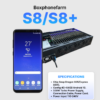Spotify algorithm is no longer an esoteric concept limited to data scientists. For marketing professionals, independent musicians, record labels, and especially those operating in the dynamic world of MMO through music promotion, understanding the inner workings of this recommendation system is the key to unlocking massive growth. Beyond casual listening, there is a data science that drives music discovery. Get ready to go beyond the basics and dive into the engineering that defines success on the world’s largest streaming platform.
The Recommendation Architecture: Beyond Simple Tastes
Understanding how Spotify’s algorithm works is fundamental to any music promotion strategy. Contrary to popular belief, it is not a single algorithm, but an interconnected ecosystem of machine learning models working in tandem. These models are classified into three main types, a trio that the Spotify research community has detailed over the years:
- Collaborative Filtering Models: These are the “people like you also listen to” models. They analyze the collective behavior of millions of users. For example, if User A listens to the same 100 songs as User B, and User B discovers a new song they love (Song X), the system assumes User A will also like Song X. The strength of this model is that it doesn’t need to know anything about Song X; it only needs to know user behavior.
- Natural Language Processing Models: These models dive into the “outside world” of music. They analyze texts such as song metadata, playlist descriptions, music news articles, and blog content. If a song is repeatedly described with terms like “indie folk with touches of melancholy,” NLP categorizes it to recommend it to users who have listened to music with similar tags. They also focus on how artists and songs are grouped in the context of language.
- Audio Models: The most fascinating and purely technical models. These models ignore textual information and user behavior; instead, they analyze the audio signal itself. Convolutional and recurrent neural network models extract features such as tempo, musical key, loudness, harmonic density, and even “timbre” or instrumentation. This allows grouping new or unknown music that “sounds” similar to music the user already likes, solving the “cold start” problem for new artists.
The combination of these three models allows for a robust and dynamic recommendation. No song is recommended for a single reason, but for a composite score derived from user behavior, linguistic context, and the acoustic characteristics of the track.
Analysis of Key Algorithmic Playlists
Spotify’s algorithm is most palpably manifested in its personalized playlists. For a digital marketing strategy or an MMO operator, these lists are the jackpot, as they represent direct exposure to hyper-segmented audiences:

Discover Weekly
Launched every Monday, Discover Weekly is the masterpiece of collaborative filtering on Spotify. Its main data sources are primarily the user’s listening history and the listening history of their “neighbors”. However, there is a technical twist: DW is designed to be exploitative, meaning it prefers to recommend music that the user will probably enjoy, based on what they already know. For an artist, getting in here means their song has already been tested and approved by the “neighbors” of their target audience.
- Listening Frequency: Songs in DW mainly come from artists the user has not listened to. This ensures the user is “discovering” music.
- The Skip Rate is Vital: If a user listens to the song for less than 30 seconds, the algorithm interprets it as a “negative skip.” A high skip rate in DW destroys the song’s score.
- “Recency” is Less Important: DW often includes older music, focusing on the quality of the match, not the release date.
Release Radar
Launched on Fridays, Release Radar (RR) is a more explanatory playlist. Its function is simple: to notify the user about new releases in the last 28 days from artists they follow or that Spotify thinks they follow. It is a powerful tool to keep existing fans engaged.
- Artist Loyalty: The probability of a song appearing in RR depends heavily on the user’s previous activity with that artist.
- Fan Base Interaction: If your followers interact with the new release (save, add to personal playlist), this sends an incredibly strong signal to the algorithm: “This song is valuable to my core audience.”
The Critical Power of Listener “Engagement”
To manipulate or influence Spotify’s algorithm, simply accumulating streams is not enough. The key metric is Engagement. The algorithm does not look for streams; it looks for signals of intent, evidence that the listener is investing their time and attention. The central concept is Retention.
Spotify’s algorithm primarily observes four factors, weighted as follows:
- Complete Listening Rate: Did the user listen to the song for more than 30 seconds? And, more importantly, did they finish it? A complete listen indicates immensely superior value to a simple stream.
- Saves to Library: When a user saves a song to their library or to a personal playlist, this is interpreted as the highest quality “love” signal for the song. It is a vote of confidence.
- Shares: An indicator of natural virality.
- Additions to Personal Playlists: Similar to a save, it indicates the user’s intention to listen again.
A 31-second stream with a “Save” and an addition to a playlist is exponentially more valuable than 100 complete streams without any other interaction. The algorithm rewards the quality of interaction over raw volume.
The “Snowball Effect” in Streaming
The mechanics of growth on Spotify are based on the “snowball effect.” An artist or a song does not go viral spontaneously; it is an iterative process of algorithmic validation.

The Positive Feedback Loop:
- Phase 1: Initial Interaction: The algorithm tests a new release with a small sample of your core audience. These streams must have a high complete listening rate and, crucially, a high save/add to personal playlists rate.
- Phase 2: Validation: If the initial interaction is solid, the algorithm interprets the song as a “success” for that small group and “graduates” it to the Discover Weekly of that group’s “neighbors.” This is called the Neighbor Expansion Phase.
- Phase 3: Massive Growth: If the song maintains high performance in the Discover Weekly lists of Phase 2, the algorithm considers it a “universal success” for a genre or niche. At this point, the song becomes eligible for Editorial Playlists and exposure skyrockets. Growth is no longer linear, but exponential.
The critical point is: without the initial and high-quality interaction (Phase 1), the “snowball” never starts rolling.
The Challenge of Starting the Snowball
For the independent artist or label releasing a song, the biggest challenge is Phase 1: How is that high-quality initial interaction generated (many saves and listen-throughs) before the song disappears into the vast sea of 60,000 daily releases?
Organic tactics are inconsistent and not scalable. Traditional paid advertising can generate clicks, but it does not guarantee Engagement or complete listening, which often results in a high Skip Rate that actually damages the song’s score with the algorithm.
A solution is needed that can inject a controlled volume of authentic, programmed, and high-retention interactions, simulating the behavior of an extremely loyal fan base, right when the song is released.
GenFarmer: The Catalyst of Algorithmic Interaction
This is where cutting-edge automation solutions like GenFarmer become an indispensable technical advantage. GenFarmer, specifically with the GenFarmer Spotify module, is designed to solve the Phase 1 problem by generating thousands of small, positive, and high-fidelity interactions that act as the initial engine of the snowball.
Our approach transcends the simple accumulation of streams. It focuses on the algorithmic signal:
- Loyal Fan Base Simulation: Our system uses no-code automation techniques through our platform, employing a distributed network of unique devices and environments.
- Programmed and Quality Interactions: Simulated interactions are not a simple bot click. The system is programmed to:
- Listen to the song beyond 30 seconds.
- Simulate the act of “Saving” to the user’s library.
- Simulate adding the song to a personal playlist.
- Simulate pre- and post-event navigation, mimicking human behavior.
- Digital Fingerprint Isolation: Each interaction is performed from a unique environment with a real device digital fingerprint through our Cloud Phone or Box Phone Farm technology. This is vital. Spotify’s algorithm is expert at detecting “click farms” through duplicate device digital fingerprints or data center IPs. GenFarmer overcomes this by using our Box Phone Farm hardware solution and Proxy & VPN solutions to ensure that each interaction appears to come from an individual user in a different household.

The combination of high-quality interaction and hardware-level digital fingerprint isolation allows the song to receive the positive signals it needs to be validated by Spotify’s algorithm and initiate Phase 2 expansion.
Technical Analysis: Listener Cluster Simulation with GenFarmer
For technical professionals seeking a deeper understanding, GenFarmer’s value lies in its ability to simulate listener clusters. The goal is not just to generate streams, but to ensure the song is introduced to the correct algorithmic “neighbors.”
GenFarmer uses a three-layer strategy:
Layer 1: Acoustic Segmentation
Before interaction, a micro-segmentation is performed: the client’s song is compared with the characteristics of songs in Spotify’s main catalogs that have high performance in the target genre. This ensures that GenFarmer’s interaction does not target a hip-hop cluster if the song is jazz.
Layer 2: Environment Isolation
Once the cluster is identified, GenFarmer ensures that every Box Phone Farm device performing the interaction has the characteristics of that cluster. This includes:
- Time Zone and Geography: The Cloud Phone or Box Phone Farm device simulates the exact time zone. If necessary, our Proxy & VPN solution is used to assign a residential IP address compatible with that geography, avoiding high-risk data center IPs.
- “Neighbor” Listening History: The automation device is nurtured with a small listening history that includes songs the algorithm has already categorized in that specific cluster. This reinforces the signal that the listener is a legitimate “neighbor.”
Layer 3: Human Behavior Simulation
GenFarmer devices replicate the randomness of human behavior to avoid pattern detection. Automation scripts do not just listen, but introduce variability and noise. For example, the duration of the complete listen may vary ±5 seconds, and the time between listening to and saving a song is randomized. Furthermore, our technology is designed to simulate the micromovements of the device’s sensors, a technique that platforms use to detect if the phone is “static.”
By successfully simulating the three layers (acoustic, isolation, behavior) in a real device digital fingerprint environment, GenFarmer not only generates streams but injects high-quality cluster validation proofs directly into Spotify’s algorithmic engine, forcing the snowball to start rolling.
Conclusion: The Competitive Advantage of Intelligent Automation
Spotify’s algorithm – with collaborative filtering, NLP, and audio analysis – is not an obstacle but a system that responds to clear and consistent signals. Understanding it matters, but the real advantage arises in execution: prioritizing the quality and authenticity of initial engagement and avoiding detectable simulations that platforms penalize.
Scale with hardware-level fingerprint isolation and operate without blocks with GenFarmer; boost releases with Cloud Phone, ensure unique IPs with Router & Mini PC and run massive operations with Box Phone Farm. Talk to an expert and turn signals into predictable revenue.











